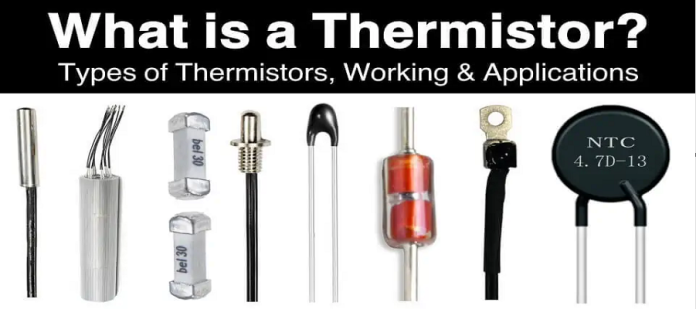The concept of thermistors was born in 1833, when Michael Faraday, an English physicist, and chemist, while reporting on the semiconductor behaviour of silver sulphide, noticed that the silver sulphide’s resistance decreased with increasing temperature. This discovery later led to the commercial manufacturing of thermistors in the 1930s.
What is a Thermistor
Thermally sensitive resistor, thermistor is a semi-conductor type of resistor that exhibits a precise change in resistance over the temperature change. They are part of a larger group of passive components. They possess greater resistance than conducting materials, but lower resistance than insulating materials.
The term “thermistor” is an amalgamation of the words “thermal” and “resistor”. They are also defined as thermally sensitive resistors whose resistance is dependent on temperature. They are made of metallic oxides, pressed into a bead, disk, or cylindrical shape, and then encapsulated with an impermeable material like epoxy or glass. The relationship between a thermistor’s resistance and its temperature is highly dependent on the materials used in its composition. The precise ratio of the composite material governs its resistance/temperature curve.
Thermistors come in several common configurations. The three most commonly employed are-
- Hermetically sealed flexible thermistor (HSTH series)
- Bolt-on/washer type
- Self-adhesive surface-mount type
Thermistors are highly accurate (ranging from +-0.05 degree Celsius to +-1.5 degree Celsius), but only have a limited temperature range that is within 50 degrees Celsius of the base temperature. The working temperature range for most thermistors is between 0 degrees Celsius to 100-degree Celsius. Thermistors’ major use is in measuring the temperature of a device. In a controlled environment, a thermistor is a small but important part of a larger system.
Thermistor – Working Principle
Thermistor works on the simple principle of change in resistance due to the change in temperature. The thermistor has a non-linear resistance temperature curve and cannot be characterized by a single coefficient. This means the resistance of a thermistor decreases with the increase in temperature. The thermistor starts self-heating its elements, and its resistance value is changed concerning the temperature change, once the ambient temperature changes.
When current flows through a thermistor, it generates heat, which in turn raises the temperature of the thermistor. In case the thermistor is used to measure the temperature of the environment, this heating may cause a significant error, also known as an observer effect.
Types of Thermistors
Like all resistors, thermistors resist the electric current. The Positive Temperature Coefficient (PTC) and Negative Temperature Coefficient (NTC) are the two major types of thermistors that are widely used in temperature-sensing applications.
- Negative Temperature Coefficient (NTC)
In NTC-type thermistors, resistance decreases with an increase in temperature. They are made from semiconductor materials with conductivity between electrical and non-electrical conductors. When a component heats up, electrons are loosened from the lattice atoms. As temperature increases, a thermistor transfer electricity easily and effectively. It is to be noted though, the way of conduction of NTC thermistors varies with the type of material used in their manufacturing. Depending on the temperature range to be measured, the material of the thermistor is decided.
- Germanium – 1 kelvin (K) to 100 kelvin
- Silicon – up to 250 K
- Metallic Oxide – 200 K to 700 K
To measure higher temperature ranges, thermistors are manufactured using aluminium oxide, beryllium oxide, zirconium dioxide, dysprosium oxide, etc. NTC thermistors are available in various sizes to fit applications. The glass-encapsulated NTC thermistors are completely sealed to eliminate any possibility of reading errors. Their encapsulation makes them useful for severe environmental conditions. They have an operating range of -67 degrees Fahrenheit to 392 degrees Fahrenheit. The NTC thermistors are accurate, have a quick response time, and are very convenient for placement.
- Positive Temperature Coefficient (PTC)
The resistance in the PTC thermistor increases with an increase in temperature. PTC thermistors have two main variants – one which shows a linear increase in the resistance known as silicon, while the other known as switching demonstrates sudden changes in resistance. Switching the PTC thermistor is non-linear. Their resistance initially falls a little with an increase in temperature. Once the temperature reaches a certain level, the resistance increases exponentially which makes it ideal for safe and protective use. They are made from polycrystalline material, such as – barium carbonate or titanium oxide, silica, or manganese. The Silistor PTC thermistors are linear and have a semiconductor as their base material. Most PTC thermistors have lead wires, but also come in chip form, and are found in various temperature-sensing devices and equipment.
Application Areas of Thermistors
Thermistors have diverse applications ranging from temperature compensation to temperature measurement, temperature control, and Inrush current limiting. Let us closely look into various applications of PTC and NTC-type thermistors-
- PTC Type Thermistors
- As a current-limiting device for circuit protection.
- As timers in the degaussing coil circuit of most RT displays
- As heaters in the automotive industry provide additional heat inside the cabin with a diesel engine or heat diesel in cold climates before engine injection.
- In crystal oscillators for temperature compensation, medical equipment temperature control, and industrial automation.
- To prevent current hogging in electronic circuits
- To prevent thermal runaway in electronic circuits
- An electrically actuated wax motor provides the heat necessary to expand the wax
- In temperature-compensated synthesizer voltage-controlled oscillators
- NTC Type Thermistors
- As a thermometer for low-temperature measurements
- To monitor the temperature of an incubator
- As an inrush current limiter device in power supply circuits
- In the food handling and processing industry, for food storage systems and food preparation
- Point Sensing to achieve high accuracy for specific points, such as laser diode die
- For measurement of the temperature profile inside the sealed captivity of a convective
- Thermistor Probe Assemblies offer protection for the sensor in harsh environments
- Throughout the consumer appliance industry for measuring temperature









